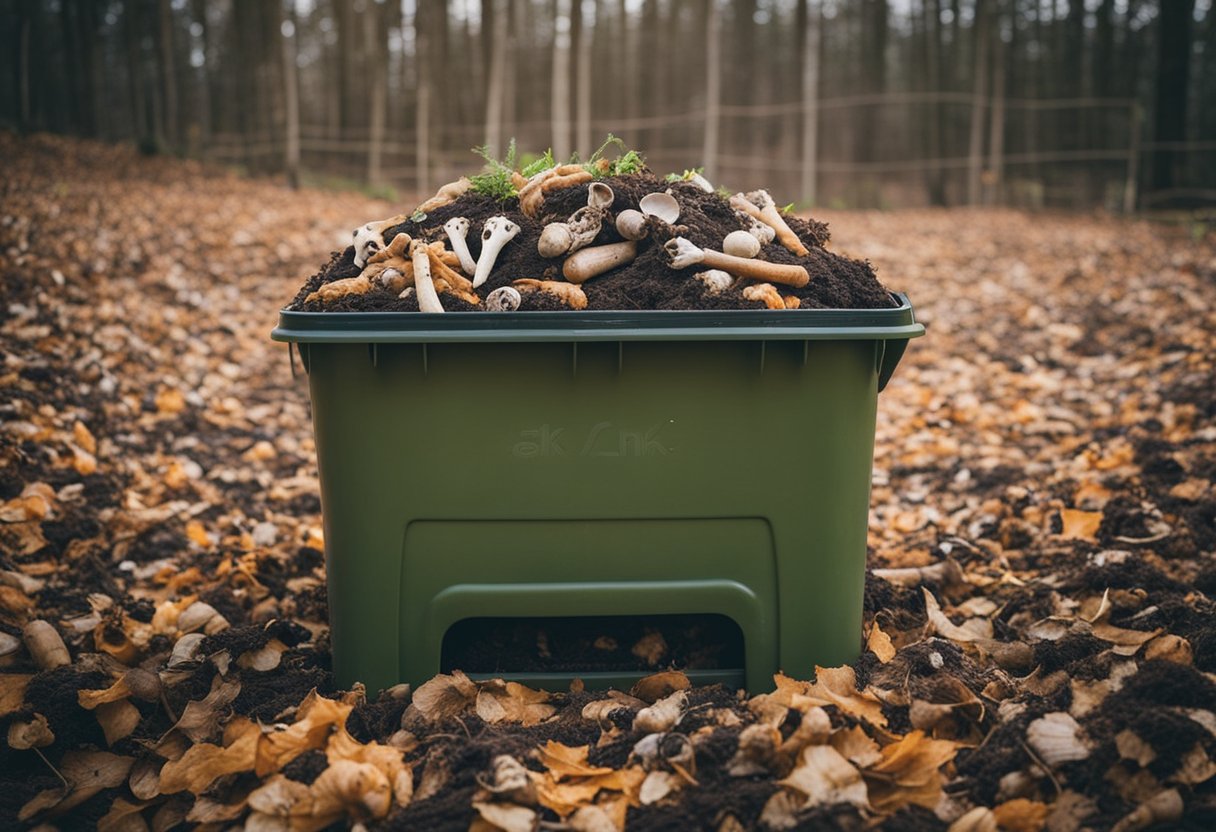As an Amazon Associate I earn from qualifying purchases.
At A Glance
It is not recommended to compost animal bones as they do not break down easily and can attract pests to your compost pile. Composting bones requires a high-heat composting system to facilitate decomposition and kill off any pathogens. Most home composting systems do not achieve the necessary temperatures to safely compost bones. However, there are other methods of disposal such as sending them to a rendering facility or utilizing a bokashi composting system, which is specifically designed to handle meat and bone waste. If composting is not an option, consider other eco-friendly disposal methods like using bones to make broths or stocks before disposal
Composting is an excellent way to reduce waste and create nutrient-rich soil for your garden. However, many people are unsure if they can compost animal bones. The answer is yes, you can compost bones, but there are some important things to keep in mind.

Firstly, bones take longer to decompose than other organic matter, such as fruit and vegetable scraps. Depending on the size and density of the bones, it can take anywhere from six months to two years for them to break down completely. This means that if you want to use your compost sooner rather than later, it’s best to avoid adding large bones to your pile.
Another consideration is that bones can attract pests, such as raccoons, dogs, and rodents. The scent of decomposing bones, including marrow and meat residues, is enticing to these animals. To prevent this, it’s important to secure your compost bin with a lid or cover your open pile with a sheet of metal or wood.
Understanding Composting

Composting is the process of breaking down organic matter into a nutrient-rich soil amendment. It is a natural process that happens when microorganisms, such as bacteria and fungi, break down organic matter.
Basic Composting Principles
Composting requires a few basic principles to be successful. The compost pile needs to have a balance of carbon and nitrogen, also known as browns and greens. Browns are materials like dead leaves, straw, and sawdust, while greens are materials like grass clippings, food scraps, and manure. The ideal ratio of browns to greens is 3:1. The pile also needs oxygen and moisture to keep the microorganisms alive and active.
Hot and Cold Composting
There are two main types of composting: hot and cold. Hot composting is when the pile is actively managed to maintain a high temperature, usually between 130-160 degrees Fahrenheit. This high temperature helps to kill off any weed seeds or pathogens in the pile. Cold composting, on the other hand, is when the pile is left to decompose naturally over time.
Hot composting is a faster process and can produce usable compost in as little as a few weeks to a few months, depending on the size of the pile and the materials used. Cold composting takes longer, usually 6-12 months, but requires less maintenance and effort.
It’s important to note that not all materials are suitable for composting. Meat, dairy, and bones should not be added to a compost pile, as they can attract pests and take a long time to decompose. However, some sources suggest that bones can be composted with careful preparation and optimal conditions.
For successful composting, it’s important to monitor the temperature, moisture, and oxygen levels of the pile. A composting guide can help you keep track of these factors and ensure that the pile is healthy and productive.
What Can Go in Your Compost
Composting is a great way to reduce waste and create nutrient-rich soil for your garden. Knowing what materials can and cannot go in your compost bin is essential for successful composting.
Acceptable Materials
The following materials are acceptable for composting:
- Garden waste: This includes leaves, grass clippings, and plant trimmings.
- Fruit and vegetable scraps: These can include peels, cores, and other parts that are not edible.
- Coffee grounds: Used coffee grounds are a great source of nitrogen for your compost.
- Organic matter: This can include things like shredded paper, cardboard, and wood chips.
- Dairy products: In small amounts, dairy products like cheese and yogurt can be added to your compost.
- Cooked food: Cooked food scraps can be composted, but it is best to avoid adding too much at once.
Materials to Avoid
The following materials should not be added to your compost:
- Meat and bones: These can attract pests and take a long time to break down.
- Fats and oils: These can also attract pests and create a bad odor in your compost.
- Pet waste: This can contain harmful bacteria and parasites.
- Diseased plants: Plants that are diseased can spread the disease to other plants in your garden.
- Weed seeds: These can survive the composting process and grow in your garden.
By following these guidelines, you can create a healthy and productive compost pile that will provide your garden with the nutrients it needs to thrive.
Composting Animal Bones

Why Compost Bones
Composting animal bones is an excellent way to reduce waste and enrich your garden soil. Bones contain nutrients such as calcium and phosphorus that can benefit your plants. However, it is essential to compost bones safely to avoid attracting pests and producing unpleasant odors.
Types of Bones to Compost
Not all bones are suitable for composting. Large bones such as beef bones and wild game bones take a long time to decompose and may not break down completely in a typical compost pile. Chicken bones, pork bones, and fish bones are smaller and can break down more quickly.
It is best to break the bones into smaller pieces before adding them to the compost pile. This can be done by using a meat grinder or a food processor. Breaking the bones into smaller pieces will help them decompose faster and reduce the risk of attracting pests.
How to Compost Bones
To compost bones, it is essential to create the right conditions. Bones should be added to a compost pile that is well-aerated and has a balanced mix of green and brown materials. The compost pile should be turned regularly to ensure that the bones are evenly distributed and exposed to oxygen.
It is also important to monitor the temperature of the compost pile. The ideal temperature for composting bones is between 130 and 150 degrees Fahrenheit. If the temperature is too low, the bones may not decompose properly, and if the temperature is too high, it may kill the beneficial microbes that break down the bones.
Bones can take a long time to decompose, so it is important to be patient. Depending on the size of the bones and the conditions of the compost pile, it can take several months to a year for bones to break down completely.
In conclusion, bones can be composted safely and can provide valuable nutrients to your garden soil. By following the guidelines outlined above, you can compost bones effectively and reduce waste in your home.
Composting Challenges and Solutions
Composting animal bones can pose some challenges that need to be addressed to ensure a successful composting process. Here are some of the common challenges and solutions to composting animal bones.
Potential Pests
Meat and bones can attract pests such as rodents, flies, and raccoons to your compost pile. To prevent these pests from getting attracted to your compost pile, it is important to bury the bones deep into the compost pile or use a compost bin with a tight-fitting lid. Avoid composting cooked meat and bones as they can attract more pests due to their strong smell.
Preventing Diseases
Composting meat and bones can also pose a risk of spreading pathogens such as E. coli if not done properly. To prevent the spread of pathogens, it is important to maintain the right balance of carbon and nitrogen in your compost pile. Make sure to add enough carbon-rich materials like leaves, straw, or sawdust to your compost pile. It is also important to maintain a temperature of 135-160°F for at least three days to kill any harmful pathogens.
Effective Decomposition
Bones decompose at a very slow rate due to their rigidity. To speed up the decomposition process, it is important to break the bones into smaller pieces before adding them to your compost pile. You can use a hammer or a bone grinder to break the bones into smaller pieces. Adding bone meal to your compost pile can also help speed up the decomposition process.
In addition to the above challenges, composting meat and bones can also lead to mold growth and fermentation. To prevent mold growth, make sure to maintain a good balance of moisture in your compost pile. If your compost pile is too wet, add more dry materials like leaves or sawdust. To promote microbial activity, turn your compost pile regularly to ensure proper aeration.
Overall, composting animal bones can be challenging, but with the right techniques and precautions, it can be done successfully.
Benefits of Composting Bones
As it turns out, composting animal bones can be beneficial for both your garden and the environment. In this section, I will discuss the advantages of composting bones and how they can enrich your soil.
Nutrient-Rich Soil
Composting bones can create nutrient-rich soil that is beneficial for plant growth. Bones contain calcium phosphate, which is a vital nutrient for plants. When bones are composted, the calcium phosphate is broken down and released into the soil. This makes the soil more fertile and provides plants with the nutrients they need to thrive.
Environmental Impact
Composting bones is also an environmentally friendly way to dispose of animal byproducts. When bones are thrown in the trash, they end up in landfills where they take up space and contribute to greenhouse gas emissions. Burning bones is also not a good option as it can release harmful chemicals into the air. Composting bones at home is a great way to reduce waste and create a useful product in the process.
In addition, composting bones can also reduce the need for chemical fertilizers in your yard. Bone meal, which is made from ground-up bones, is a natural fertilizer that is high in nitrogen and calcium. By composting bones, you can create your own bone meal fertilizer and use it to nourish your plants. This can help reduce the amount of synthetic fertilizers you use, which is better for both the environment and your plants.
Overall, composting bones is a great way to create nutrient-rich soil amendment while reducing waste. Whether you use a backyard compost pile or vermicomposting, bones can be a valuable addition to your compost. By composting bones, you can create a sustainable source of calcium and nitrogen for your plants, reduce waste, and help the environment.
